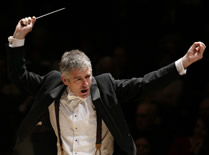The formal program of pianist Murray Perahia‘s latest recital at Duke, presented in Page Auditorium for Duke Performances‘ Virtuosi series, featured music by Beethoven, Bach, Schumann, and Chopin. It was a generous evening during which the artist held his audience largely spellbound through the elegant, stately magic of his playing and his quite incomparable interpretive skills. For many of his listeners — including this writer — Perahia is our greatest living pianist, one whose concerts and recordings linger in the memory long after the work of other performers has faded away. Such was the case on this occasion when, before a near-capacity crowd, he began with Beethoven’s Sonata No. 9, in E, Op. 14/1. This sonata and its companion work, Sonata No. 10, in G, Op. 14/2, rarely surface in programs of our blockbuster players, for they seem relatively simple and straightforward, and they offer no place to shake one’s fists at heaven. Perahia’s playing of both of them, separated by Bach’s Partita No. 3, in A minor, S.827 – yet another stroke of programmatic genius from our visiting artist – proved revelatory on many levels, not least of which was his exceptional control of dynamics and line. (He asked much of the instrument, and for the most part it responded well, although there were occasional spots of featheriness in the mid-range and top in the sonatas and the partita, too.)
If one is going to hear Bach played on a big piano, then Perahia is one of the best people to play it. No purist will be fooled by the sonority, but he’s an absolute master of clear projection, and even a barely-musically-literate person could probably transcribe the music as Perahia plays it, so beautifully illuminated it is in his hands. Folks new to Perahia’s Bach might have encountered some surprises. He plays from the heart, or so it seems, so the slow sections sing extraordinarily. Brisker passages can be at once dramatic and quite wide-ranging, dynamically. What appears to be at times astonishing speed most likely stems from the pristine quality of the articulation and minimal pedaling. The cheers – restrained, to be sure – began after the Bach, as excitement built up in the hall.
That excitement carried through all of the G major Sonata that brought the first half of the concert to a close. Some people were sitting on the edges of their seats, others were absorbed in their own personal reflections on the music. That the top line of the second movement might have benefited from a bit more singing makes one think the voicing of the piano could stand some touching up, but there were no long-term issues for the audience, from which applause erupted as this middle section ended. The finale, a rollicking Scherzo, unfolded at what seemed like breathtaking speed, and the place went wild at the actual close of the piece.
Part two began with what was, for this listener, the evening’s most sublime performance, a radiant, glowing-from-within reading of Schumann’s Fantasiestücke, Op. 12. Because some of this set’s eight numbers are often extracted for encores, civilians (which is to say, non-pianists) most likely didn’t know all the parts equally well. No matter. Perahia played them as if they were fresh off the presses, bringing them to glorious life. Those who thought they knew the best-known numbers – “Aufschwung,” for example, or “Traumes Wirren” – must have shaken their heads in amazement at the performances Perahia gave.
The concert ended with Chopin’s Ballade No. 4, in which the artist came closer to celebrating what we think Chopin did, in terms of dynamics, than any other player who’s worked this circuit in recent memory. There was understatement in good measure at the start, which drew in the listeners with great effectiveness. Perahia then built up the music gradually, almost imperceptibly, exercising control in ways that set him aside from the competition, for sure. The finale sizzled, and the audience leaped to its feet, recalling the pianist repeatedly. Along the way, he capped his generous program with three encores, likewise played from the heart: a Brahms intermezzo and, from Chopin, an étude and a nocturne.
Perahia is not a demonstrative artist – all the emotion and passion go into his playing, and there’s virtually no flapping or flailing along the way. He makes it all look and sound so easy. On this night, with scads of pianists and piano players in the hall, I was reminded of the famous old lines about a Great Keyboardist of the Past, whose playing prompted a lesser performer to opine, “Warm night, eh?,” prompting the response – from a violinist – “Not for fiddlers!” That said, it was clear that the Duke audience adores Perahia – and that he was pleased to be back. There were hints of smiles here and there, during the thunderous applause. And his little wave goodbye after that encore demonstrated lots of character and personality, too – as if the music hadn’t. In truth, however, some of us would gladly have sat there and listened all night, had he been willing to keep playing. Perahia is that compelling, that good.
The title of this review is a précis of what you’ve just waded through. I was tempted to put the single word “superb” on this page and turn it in. In retrospect, it would have done nicely.
The concert marked Perahia’s fifth recital at Duke, starting in 1974. His last Triangle performance was in Fletcher Opera Theatre, for the NCS’ late-lamented Great Artists series. It would also appear that he played one of his first engagements with orchestra at Duke, when Allan H. Bone was the Duke Symphony’s Music Director; alas, no one seems certain of the date, but we’d welcome information on that program if any of our readers recall it.











